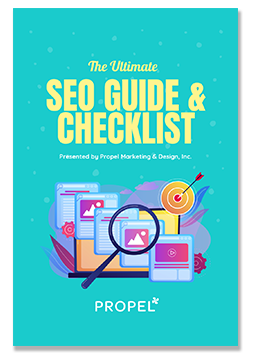SEO (search engine optimization) has come a long way since the days of tricking Google with keyword stuffing or trying to purchase unethical backlinks. But it’s not only your standard, non-technical SEO practices that have evolved, you also need to pay attention to the technical SEO side.
Technical SEO can sound intimidating for some (ok… most people), but it doesn’t have to be. We’ve created a technical SEO checklist that will benefit all companies utilizing digital marketing, without getting too crazy with the tech jargon.
You read correctly: it’s technical SEO, simplified.
In this post we’ll go over:
- What technical SEO is
- Why technical SEO is so important
- The technical SEO checklist you need to know
- Tools that will help you win at technical SEO
So, let’s do it…
What is Technical SEO?
Almost everyone who has an online demographic knows at least a little bit about the importance of non-technical SEO, which is basically providing high-quality content and backlinks so your searchers can find you organically on the SERPs (search engine results pages).
And, that’s a correct response for sure. And, you do indeed need quality content and awesome backlinks to get up there on Google. But that ain’t all you need. Not anymore.
So, it’s interesting when those same people are asked about technical SEO.
There’s gonna be a lot of shoulder shrugs and stammering involved in that answer.
And, that’s not on them, even SEO experts have a tough time wrapping their head around technical SEO. That’s because it’s a newer practice and just gaining its own importance. Algorithms are always upping the ante when it comes to SEO, and nothing says “technical” like the word “algorithm”, am I right?
But just because it’s become a new force to be reckoned with, doesn’t mean you can ignore it. It’s relevant and needs to be a priority to you and your SEO campaign as a whole.
So, what is it already, then? Although this question can inspire a plethora of answers, we’re gonna keep it easy.
Technical SEO is what supports your non-technical SEO through stability and browsability. It’s all about what’s happening behind the scenes in the details, your understanding, and the final execution.
When your technical SEO is working properly, it can really move you to those top spots on the SERPs.
And now you’re probably wondering how you know if you have a fully, optimally functioning technical SEO strategy going.
Tests. That’s right. Experimentation is key.
The following three tests will help you exceedingly:
- Unit tests– when you test one, individual function to ensure that it’s working properly
- Integration tests– when you use your logic to build a bigger and better system
- UI tests– when you test the frontend interface on your website
If this is already seeming too techy for you, don’t worry. Your checklist awaits, and it has more answers and guidance for you, but first…
Why is Technical SEO Important?
You can’t underestimate the importance of SEO and it’s constant evolution. Traditional practices have changed and technical SEO has become more and more dominant.
Technical SEO helps to drive your website’s performance and without top-notch UX (user experience), you’re just spinning your wheels.
There are so many new and revolutionary advances in SEO, notably AI, voice search, digital assistants, and progressive web apps. All of these require a significant amount of technical SEO.
So, as you can see, technical SEO isn’t going anywhere, and in fact, the need for it will only climb. Do yourself a favor and start enforcing it now. It will only help you (currently and in the future).
That’s our PSA on technical SEO.
Your Technical SEO Checklist
At Propel, we’re big into lists. So, we thought why not give our readers a great way to quickly and easily see what they need to know in order to dominate their technical SEO.
Here’s where that list landed:
Employ Robots.txt
You already know that Google is smart enough to rank you. But, do you know how it does that? Through bots. Google has bots that crawl and index your website pages, essentially “reading” them and detecting their value.
These bots provide info to Google, but they can also give you insight to your pages. So, it’s vital you understand how they operate and what they look for.
Using robots.txt gives you the power to tell the spiders (Google, Bing, Yahoo) where to look on your site because you may not want all of your pages crawled. Why? Because you have a budget with your crawls, so don’t waste any on pages that aren’t worth crawling.
If Google crawls a page that isn’t important, it can work negatively on your ranking, so be sure to set this file up from your website’s server. Go to your cPanel’s File Manager or your FTP and it’ll walk you through.
For more information on setting up robots.txt, check out Google’s advice on the matter. And be sure you have your Google Search Console set up so you can test out what you’ve done.
Check For and Handle Duplicate Copy
Search engines don’t like to see a whole lot of the same copy (or even very close to the same copy) all over your site. If you’ve got a large site, this may be an issue for you.
Note that duplicate copy is very often unintentional and could be something you don’t know is happening. Your site may move from an unsecure domain to a secure one. Or you may have multiple versions of your site, such a, http://www.yoursite.com and http://yoursite.com.
And, yes, there may be reasons you need to have duplicate copy, so it’s important to let Google know where you want them to take note of that content. Meaning, which page it should read or index, this is generally based on your most preferred version of it.
Create Canonical Links
You can establish this through the creation of a canonical link. This link tells the crawler that you know you have duplicate content and you’d like it to only review said content on the chosen page found at the link provided.
Your link should look something like this:
<link rel=”canonical” href=”https://example.com/your/chosen-content” />
Redirect Your Links
There are a few different ways to redirect old URLs, for SEO purposes, we’re going to look at 301 redirects.
301 redirects are ongoing and permanent redirects to a new page. So, say you’ve redesigned a page, keeping the copy the same. Google has both of those pages and it looks like duplicate content. If the page is redirected, you’re giving all the old page’s authority and safety to the new version of the page.
Your link should look something like this:
Redirect 301 /oldpage.html to http://www.yoursite.com/newpage.html
Like all things, too much of a good thing can be bad, so don’t overuse this. It will raise flags with the search engines and contribute to longer page-load times for your users.
Optimize Your Content
A super great way to make sure you’re dealing with duplicate content correctly (and this writer’s personal favorite) is to optimize your content.
This means you review your current content and then make it better, a higher-quality, more unique. You can do this through images and/or videos, adding new information, editing or updating the content, anything that adds value while making it original.
This helps both technical SEO and allows you to add new, targeted keywords which always benefits your non-technical SEO. We call this a double win.
Be Mobile-Friendly
This should reeeaaaally go without saying at this point, but just in case… be mobile friendly. Google just released their mobile-first index and it’s no joke. Google is saying that they’re prioritizing mobile search over computer. Those are the facts!
But whether this was happening or not, your users are on all sorts of devices. You need to be prepared for all of them because you want them to have a great experience with you.
Optimize for mobile and you’re working your technical SEO.
Manage Your Page-Load Time
Nothing is worse than a slow loading page. In a world of I-need-it-and-I-need-it-now, don’t fall behind on this. Not only will this disappoint your user and in affect, you. The search engines don’t have the patience for it either.
Even if you have a stellar page totally worth the time of the crawlers, they’ll bounce if it takes too long to get to it.
Your page should be completely loaded within four seconds, and above-the-fold should be up in under one. ONE. So how do you do that?
Compress Your Images
This is easy, folks. Images take up space, so make sure you compress them into an appropriate and readable scale.
There are loads of tools for this and most will compress on auto for any new images you add. But you can also do it yourself by saving your files “for the web”.
Don’t let this get by you because it is a guaranteed way to speed up your load time.
Minify Your Resources
This is pretty much just cleaning up your HTML, JavaScript, and CSS code by using a plugin. Be careful when you do this, not all plugins are compatible with the theme developers.
If a plugin doesn’t work with your theme and you use it anyway, it can cause serious web issues that no one wants. Yes, shaving off seconds is important, but not as important as having a functioning site.
Save With Cache
When you cache a page it means that file is essentially saved and needs no time to load once it’s pulled up again.
I did say “again” because the first time a user heads to your page, cache won’t do anything to help your page speed. The page gets seen by the user first, then the file is saved and helps with load-speed in the future.
If you install a plugin for this, be sure it’s not overlapping another plugin for the same thing. Some servers have a cache automatically installed, so do your due diligence prior to adding unnecessary and possibly destructive plugins.
Be Sure You Have a Good Host
Money matters here. Don’t try to find a host that’s super cheap, it will NOT pay off in the end. Your host needs to be close and attainable.
Have a CDN
CDNs (content delivery networks) will track a user’s location in order to provide a server that’s near them to send them your website files. This allows the user to download files faster because if the user is in the US, a US server is used to send the files and if the user is in the UK, a UK server is used.
This is definitely something you want in your page-load speed arsenal.
Note: Some hosting companies automatically include the use of a CDN with your hosting account. If you’re considering using a CDN, check first with your hosting company.
Test Your Speed
Like we said in the beginning, testing is key to technical SEO success. You won’t know how you’re doing unless you test yourself. Luckily, there are a bunch of tools you can use to check your site’s speed.
Use a tool that not only tells you how you’re doing, but also how to fix it so you’re better.
Spy
One last thing we highly recommend. Spy. Look at what your competition is doing and then do it better. Find out how their load times compare to yours and if they work well on a mobile device.
Might as well look into their keywords too, I mean, you’re already there…
There you have a full and comprehensive checklist for technical SEO, but are you wanting a bit of help in making all those things a reality? Look no further.
Technical SEO Tools and Plugins
Tools are great tricks of the trade. It’s not cheating, everyone uses them, and many are free, so you just gotta be taking advantage of them. Here are the best to use in order to control your technical SEO:
Siteliner– to check for duplicate content and broken links, it’s free
Copyscape– to see if anyone has stolen your content, it’s free depending on plan
Screaming Frog– to check for duplicate content, it’s free depending on plan
TF*IDF from Seobility– to tweak and optimize your current content, it’s free
Google’s mobile-friendly test– to see if your website is mobile-friendly, it’s free
Compressor.io– to compress images, it’s not free
Caesium– to compress images, it’s free depending on plan
WP Rocket– WordPress minify resources and cache plugin to help with load speed, it’s free
WP Optimize– WordPress minify resources and cache plugin to help with load speed, it’s free
Cloudflare– for CDN services, it’s not free (note, this isn’t a tool or a plugin, but a company that
specializes in CDN services)
Google PageSpeed Insights– to test your page-load speeds, it’s free
GTmetrix– to test your page-load speeds, it’s free depending on plan
SpyFu– to spy on your competition, it’s not free
The Takeaway
Technical SEO is here to stay and you should be learning it and working it. It will contribute greatly to your UX and your SEO campaign overall.
If it’s a bit too techy for you, ask your developer or web team for help, implement the tools and plugins or companies that get you the results you want, and you’re already ahead of most!
Don’t give up, you got this!











